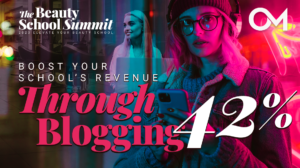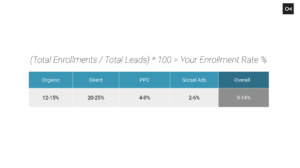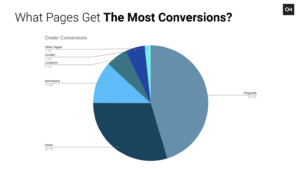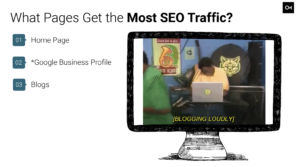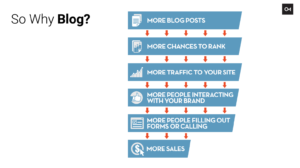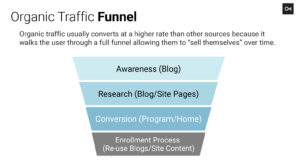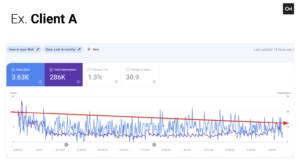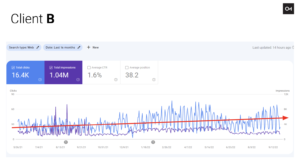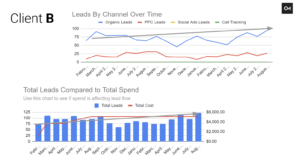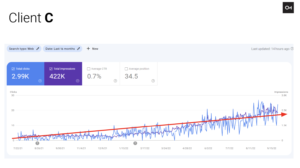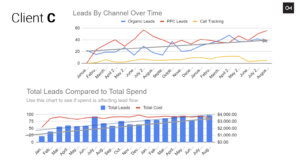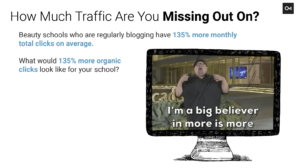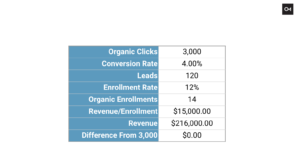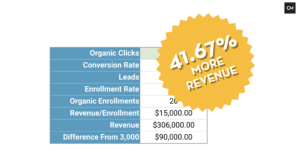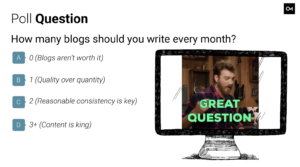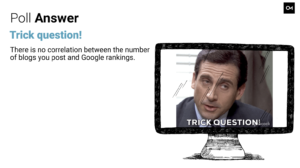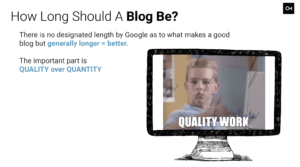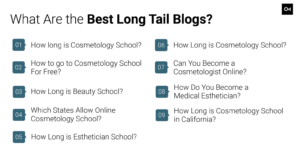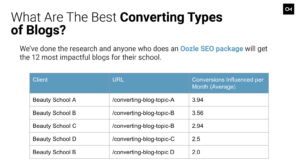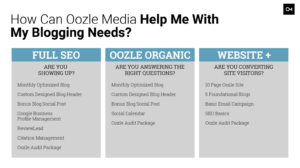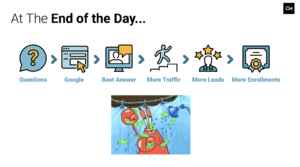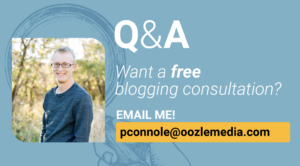How Blogging Can Increase Your School’s Revenue By 41.67%
Patrik Connole
Director of Organic Marketing, Oozle Media
Boost Your School’s Revenue Through Blogging
Patrik Connole:
All right, I’m here.
Chris Linford:
All right. Take it away, my man.
Patrik Connole:
Okay, perfect. Can everybody see that screen okay? Hopefully we got this all figured out.
Chris Linford:
Yep, we can see it just fine.
Patrik Connole:
Perfect. All right. So real quick, just to get a quick idea of like, what’s your role that you play at the beauty school? Are you in the ownership? Are you in marketing? Are you admissions? Are you a teacher? Are you student services? Let’s just get a quick idea of who’s out there. So, we got marketing, admissions, marketing sales, an owner, director of marketing, a whole bunch of different people in here. So, that’s awesome. Now, hopefully this pertains to everyone in here, you’ll get a little bit out of it. We’re going to look at this pretty in depth and we’re trying to find out how blogging, yes, that’s why I said blogging can actually help increase your revenue by just actually doing it.
As Chris mentioned, I’ve got a couple of kids and my beautiful wife, there’s a quick picture of them, they’re cute. I’ll show them off any time that I can, just like David was doing. I’ve been at Oozle Media for eight years now, nearly eight years, and I’ve loved every minute of it. Been working with beauty schools pretty much the whole time, and just have loved this industry and I’m happy to be here and working with all of you.
Traffic to Enrollment
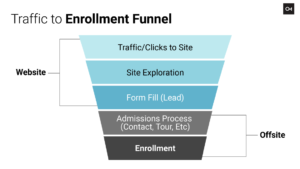
So, let’s get into it. Just like Chelsea had a funnel, I’m going to show you a funnel as well. They’re very similar, we marketers, we love funnels. They really help kind of show what we’re all about. So, when you look at this funnel here, this is how traffic or clicks to your website and people who, users who visit your website, for another word, come and eventually end up becoming in enrollment.
So, you’ll see here the first three are all things that happen on your website, traffic or clicks to your site, and then people exploring around on your site, and then they fill out a form. That’s where most beauty schools get most of their leads is from filling out a form. Sometimes you get phone calls as well, and however they get there, they try to contact you in some way, shape or form. And then they go through an admissions process, whether you have tours, you have some sort of email campaign, or however, you go through that there’s admissions process and then the actual ways of getting enrolled with figuring out the financial aid and all that jazz. That’s all offsite stuff and that’s things that are very important. But today we’re going to talk about how we can take this website experience and really bring it around so that you as a school can really get most benefit out of the content that’s being created for you.
So, this is something we talked about last year that actually Parker did, thanks Parker for doing the hard work so I didn’t have to. We looked through all of our data and we found that most schools convert somewhere in the 9 to 14% range for enrollments, this is for all leads. But if you look at that organic or SEO, anything that isn’t paid, which would be the pay-per-click or social ads, and then direct can be dependent, or direct basically means anybody who comes to your website without having done a Google search, they basically directly put in your website name. Those converted at a higher rate just in general. We put a range in there just because it depends on your school size, the traffic, location of school, all that stuff that Dave talked about earlier that I’m not going to bore you with again. It has really got some big impact on this. So, this is what we’re looking at and these will be the numbers that I use later on in my presentation.
What Pages Get The Most Conversions
So, when I looked at this, I grabbed pages from all over the whole website. I was curious, what pages are the ones that get the most conversions for schools? And you’ll notice here that about 75% of all your conversions, and in this case I’m defining conversion as anybody who contacts you, what we call in the industry a marketing qualified lead. So, it’s anybody who has contacted you in some shape or form, you have a form fill or a phone call. We find that your program pages and your homepage are the place where you get the majority of your conversions. And so those two pages are super key, and our website content director will be speaking a little bit more on this a little bit later, but these are the pages that we really focus in on and really help students or potential students become a conversion or somebody who actually reaches out to you.
And the reason I think that these are the two most popular places for that is because of program page is where the student can really get excited. It’s where they see all of the things they can learn, it gives them the information that they want and crave and it helps them make that decision. And the same with the homepage, that’s kind of a default area for most things SEO anyways. The thing that you’ll see here though, there’s no blogs, so how can I say that this can help you get conversions? Well, let’s get to that.
What Pages Get The Most SEO Traffic
These are the pages that get the most SEO traffic, your homepage and you guessed it, blogs. And I also put in there your Google business profile. Your Google Business profile isn’t a page on your site, but it also tends to be a top referrer of traffic and it has a lot of information about you.
It has your reviews, it has, in particular your reviews, but it also could have Google business posts, it could have other information about the school in general. Naomi, to answer your question, yes, this chart does explicitly exclude lead pages or landing pages in particular that Dave talked about earlier. And the reason for that is because landing pages are pretty much exclusively a paid ads area, and so you don’t get organic or SEO traffic to them. So, you’ll notice on here that there are no program pages that get the most SEO traffic. So, how do we make those two connect? Because most of the time blogs and the homepage are getting that traffic. And why is that?
So Why Blog?
Well, what happens is when you blog you get more blog posts out there, which gives you more chances to rank because people ask questions and blogs are the best place to be answering those questions.
When you answer those questions and you answer them well, you rank well, you get more traffic to your site, which means you then have more people interacting with your brand and you have more people filling out forms or calling you, which means you get more sales, you get more enrollments, you get more of whatever it is that brings in money. This is a business, it is, and so that’s why we really feel that blogging can help you out a lot.
Organic Traffic Tunnel
So, if we look at this organic traffic funnel, this traffic ends up converting at a higher rate, that 12 to 15% range rather than that lower rate of the paid ads because it walks the user through an experience that allows them to “sell themselves” over that timeframe. So, there’s awareness, which Chelsea talked about quite a bit, thanks Chelsea, which you usually get through your blog.
People have a question, how much does it cost to go to beauty school? And you answer that on your blog. Then they say, okay, great. And you have a link to another page on your site that says, check out our financial aid options, check out our scholarship options, check out our program if you’re excited about it. So, they look through other blogs, they look through pages on your site. They don’t often convert on that first visit, but they may come back, and then they’ll go to the program page, find out more details about the program, or maybe just go directly on the homepage like, yeah, I’m ready now. And then they’ll convert and then they’ll go through that enrollment process. The nice part about the enrollment process is that you can also reuse the blogs and other site content to really help you find ways of reinforcing the information that they’ve already learned.
And we do that a lot through email in particular, and that can be super helpful if your admissions people and your marketing team is able to work together, then that can help those two really work together to bring in more enrollments over time.
So, let’s look at a couple examples. This is a client that’s no longer a client of ours. They launched a new site that was not one of our sites in early of May, 2021, and made the decision to remove a lot of their blogs and then also stop blogging altogether.
Note the big red line going downwards, not what we want to see as far as traffic coming in. Unfortunately, I don’t have the lead data to go back on this because like I said, they’re not a client of ours anymore. But here is a client of ours, and this is what I would call a typical experience for most schools that work with us.
They get a new site, they got a new site in January, 2021, we launched their first blog in April of 2021. And you’ll note this slow but steady incline of the number of clicks. That blue squiggly line all across the way, that’s clicks that’s coming through, and the purple squiggly line, those are what’s called impressions or anytime that it shows up in the Google search. So, what you’ll see is as that increases, guess what?
We also see the total number of leads increase. The really nice part about this too is that you can see, if you look at that bottom chart, the total leads compared to the total spend, that total spend flat lined and they didn’t have, this client didn’t have to spend more money on top of each other to get more leads as they just kind of came in over time.
Blogs have long staying power with what they do. The other thing you’ll also note is there’s some dips on that traffic, it’s not necessarily like a straight increase of traffic, it happens with seasonality. Everybody knows that the back-to-school season is when you’re going to get the most leads regardless of what you’re doing. That’s just what’s going to happen because that’s when there’s the most interest. So, you can see some of that seasonality dips, and that’s very typical, that ebb and flow of leads coming in, but that general overarching increase.
Now, here’s a more fun example. This is the one I love because it’s the best one that I found. Look at that graph, that’s awesome, right?
This client, we launched their first blog in March of 2021, and you’ll notice that it took about six to nine months for that to really take off, but once it took off, it really started paying a ton of dividends to this client. And you’ll notice that they have a very similar leads by channel tracking point, right?
They’ve had about 20 leads when they started coming in monthly, and that doubled and bumped all the way up to about 40 leads a month. And that was a crazy. And Naomi, that’s a great question, I’m going to get to that towards the end of my presentation. You’ll also notice that the total cost there, it doesn’t flatline quite as similarly as the other client, likely because they had some fluctuation in paid ad spend, that happens. But you can see how that average increase really took off for this client, and we’re very excited to continue working with them.
How Much Traffic Are You Missing Out On?
So, how much traffic are you missing out on? Beauty schools who are regularly blogging, and I’ll talk about that frequency in just a minute, get 135% more monthly clicks to their website on average.
So, let’s look at what that would look like. Here’s an average case of a beauty school, we actually used this exact same data from last year of how many clicks you’re getting. If their conversion rate is even 4%, at that lowest range possible in that conversion rate, and this is for average site wide.
You get 120 leads, if your enrollment rate’s around 12%, that means you get 14 enrollments and there’s the money that’s attached to it. You can insert your own numbers here. Take a screenshot of that if you’d like. Let’s see what happens if we increase that traffic by 135% without doing anything at all else to your website, or anything with your paid ads or anything at all. All of a sudden you’re getting an additional 42 leads, which leads to an additional potential six enrollments if the numbers hold out. And that is where you get that 41.67% more revenue, 42% more revenue.
That is just from blogging alone, and that’s bringing in that traffic, bringing in those rankings, making it so that more people can interact with your brand and get more people filling out your forms or calling you. That’s why it’s so critical to what we do. So, let’s talk about some of those common questions about blogging.
Common Questions About Blogging
How Often Should You Be Blogging?
Okay, so number one question, I get this every single time I do this presentation. How many blogs or how frequently do you post? So quickly put into the chat, what do you think it is? A, B, C, or D? Zero, blogs aren’t worth it, quality over quantity, reasonable consistency, content is key, we must blog all the time.
Okay, I’m seeing a lot of Bs and Cs, Ds. Perfect. So, let’s look at the answer. It’s actually a trick question, I’m sorry. I apologize. There is no correlation between the number of blogs you post and your Google rankings.
Now, the reason why this is important is because it doesn’t matter the quantity of blogs. If your focus is quantity, you’re doing it the wrong way. Your focus must be quality. They are better off posting a single quality blog every once in a while, than you are posting 30 blogs in a month that are 300 words long, that just don’t really make the cut. In fact, that might actively hurt you.
So, how long then should a blog blog be? Once again, there’s no designated length by Google as to what makes a good blog. Generally speaking though, more is more, longer is better. Google likes more, okay?
Google loves themselves from Google and they love quality over quantity. So, now the question that I now am starting to get over the last few months is how does AI help here? So, what we can do overall is we can build out more blogs and even better blogs at no additional cost. Now, there are some pitfalls, Parker alluded to them and showed you directly some of those there, right? Compliance, a lack of originality, potential for SEO to blow up. Google was checking for AI detection, so how can I say, oh yeah, AI is great here. What we do at Oozle is we combine our expertise in the beauty industry alongside AI. AI, I love to say it does a really good job at giving you the 80%, that first rough draft. You remember in college when you were supposed to write a rough draft and then do another draft? But half of you submitted your rough draft anyways because you didn’t want to write anymore, and that’s why you went into a different industry? So, this is what is important here, AI can give us a good rough draft. And then what we do is we’ve trained, we train our people and we have years of experience in this industry to edit for compliance. We fact check sources, we make it personable to the client.
We don’t just copy and paste a prompt out of ChatGPT, a myriad of other solutions that we have tested out and we have tried and we have just determined are not as useful for us. That human connection is really key. So, what we do is what we focus a lot on prompt writing. And you may have noticed from Parker’s presentation that when they showed that one with the building, it had a much longer prompt with a lot of specifics that was clearly designed by an expert it got better results. And that same concept applies to content in general. So, we’ve been dedicating time to this and effort over the last four or five months, however long it’s been that ChatGPT really exploded and all this AI stuff, and we’ve gotten into a good rhythm of this. ChatGPT can be, basically it’s glorified predictive text, right? So, when you are writing an email in Gmail and it starts saying, do you want to say this? And you say, yes, that’s exactly what I was saying. It likes a lot of patterns because that’s all it knows, that’s what robots are really good at, recognizing patterns and exploiting those patterns.
So, what really we do when we put in a prompt we have a formula that helps us make these prompts better, it gives a lot of context to the machine and it gets very granular with what we can do, and that’s how we can start generating more varied content in those. We also do things like just doing it for an outline, or we can do it for just small snippets of it. It really helps my writers in particular to overcome some writer’s block or to continue to be able to feel creative. At the end of the day, the benefit of using this AI is that we are actually able to get you longer and better, more well written blogs because it doesn’t take us as much physical time to actually type on a keyboard the things that are needed in order to have a great blog.
What Are The Best Long Tail Blogs?
Here are nine examples of really good blog topics. You can take these and you can try to write about them of what you need to do. These are the topics that we are writing about and that we do. When we write about how long is cosmetology school, that’s not going to be too crazy different from school to school or state to state.
It may depend a little bit on what other courses you’re offering, what other benefits you have there. I pulled this for free from a website called moz.com, and I’m sure Parker is listening and he’ll put that into the chat for me. You can go in and you can pull the same data yourself. Literally hundreds or thousands of people are searching for this every single month. And so we’ve pulled this and we also have a paid version of Moz and we pull an extensive amount of keyboard data in, and we’ve done this for a long time.
What Are The Best Converting Blogs?
And so we will take that research that we’ve done, and anybody who does an Oozle SEO package with us gets those 12 most impactful blogs for their school. These are some real data from real schools over the course of a year where these beauty schools put in these converting blog topics and they got an influence in the conversion because I can see in Google Analytics where somebody landed on a blog and then they went to a program page or a homepage or somewhere else, and then they ended up converting, anywhere from two to four additional conversions every single month.
And some of those blogs were written in 2012. It’s incredible how long a blog can have staying power in this industry. And on top of that, if you’re continuously updating it with the most recent information, Google loves it when you do that, you have existing content, you update and say, hey, this is the newest and most recent step stuff. That’s what makes it really vital to you.
How Can Oozle Media Help You?
hese are just some of our packages, yes, I’m putting a little bit of a pitch out there, but I firmly believe that these will be really helpful to you. Cole can get you a free assessment on this. Just head on to our website, submit a form, you can shoot him a text, whatever you want to do. Get ahold of us, we’re really here to help you out. And realistically at the end of the day, potential students have questions.
They go to Google, heck, they go to TikTok, they go to Facebook, they go to lots of different places to get that answer. And if you can show up, whether it be on Google, whether it be on TikTok, whether it be anywhere that you can be showing up, and you have that right answer, you have that best answer, you will get more traffic to your site, even if you’re doing it on TikTok or Google or wherever it is. The point is to get more traffic to your website or to you in general, get you more leads, which will then get you more enrollments, and then we can all be here like Mr. Krabs just running in the money. I think that would be great for all of us, right?
Need Help With Your Blogging? Talk to Patrik!
If you want a free blogging consultation, send me an email. And then if you want the slides, this QR code, you can view that and it’ll have all those blog topics on there, just for you, Deborah, and anybody else who might want it as well. Go ahead and scan that QR code and you can pull all of my slides in there. Chris, I think you can talk again now.
Chris Linford:
Oh, thank you. Hey, everybody put in the chat your love for Patrik. Give him a thank you, a shout-out.
Patrik Connole:
Or if there’s any questions, I think I got another minute or two maybe.
Chris Linford:
Yeah, if you have questions too, but a lot of people are showing a lot of love. I mean, here’s the thing, if you think something’s old school, look at the data. You should always let the data be telling you what you should be doing.
Patrik Connole:
Sounds like the QR code is disabled, because I’ve had this for a little bit while. So, we’ll put my email back onto here and then you guys can shoot me an email and I’ll make sure it gets to you.
Chris Linford:
Okay. All right. Yep, everybody take a look at that email for Patrik if you want to get ahold of him.
Patrik Connole:
Perfect. Okay. Thanks, Chris.
Chris Linford:
Okay. Thanks, man.

